
Desiree Pilgrim-Hunter never dreamed she’d become an activist. “I was just a mom concerned about school overcrowding,” she says, until a neighbor invited her to a meeting of a local community organization, the Northwest Bronx Community and Clergy Coalition (NWBCCC). “I was used to people complaining about what was missing in our community,” she recalls. “It was at NWBCCC that I first heard people talking about how to bring about solutions.”
Public schools in the Bronx were overflowing, she learned, because the population was growing. And although the shopping options in the area were multiplying, investment in public services like schools wasn’t keeping up.
When she joined the board of the Coalition in 2005 and discovered that the local armory was lying empty, Pilgrim-Hunter found herself engaged in a deep public process of imagining what might be brought in to fill the building: not another low-wage mall or a big box store to benefit some far-off owner, but a project that offered real opportunities for her children and her grandchildren; something that would lift the spirits and boost the economy of local people.
“We knew we didn’t need a mall,” she says. “More poverty wages in this, the poorest urban district in the country? Just to send another generation into poverty?”
This fall—more than a decade later—Hunter-Pilgrim gazed past the chain-link fence that still surrounds the block-long Kingsbridge Armory, and peered into what was once the National Guard Drill Hall. At 180,000 square feet, the cavernous room is big enough to contain a world of dreams—and right, now it’s holding hers. “What we need in the Bronx isn’t just jobs. It’s a new economy,” she said.
“Our new economy: this is it. This is where it starts.”
The Bronx on Ice
A long-empty landmark building in the Northwest Bronx is set to become what is being billed as the largest indoor ice-skating center in the world, according to a plan approved by the New York City Council this December in a 48-1 vote. The 750,000-square-foot Kingsbridge National Ice Center will feature a suite of nine rinks, including a 5,000-seat rink for international competitions. It will attract the world’s greatest athletes, say its backers, who include former New York Rangers star Mark Messier and figure skating Olympic gold medalist Sarah Hughes.
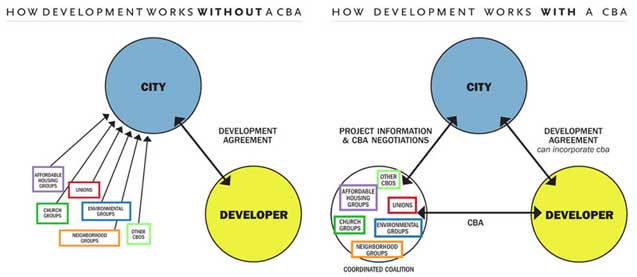 Research from Community Benefits Agreements: Making Development Projects Accountable by Good Jobs First. Graphic designed by Michelle Ney/YES! Magazine.
Research from Community Benefits Agreements: Making Development Projects Accountable by Good Jobs First. Graphic designed by Michelle Ney/YES! Magazine.
The Bronx Armory development will also be a highly visible test of a new tool that’s in vogue in development circles: Community Benefits Agreements, or CBAs. These are private cooperation agreements between developers and community organizations, drawn up with the purpose of securing benefits for the community from the development project; and, for the developer, ensuring community support—or at least acquiescence—during the city’s official approval process.
In 2009, a plan to turn the same armory into a shopping center failed largely because the NWBCCC and local unions protested that it would promote low-paying jobs and displace local businesses.
The ice center promises to bring far fewer jobs than the proposed mall, but it won support nonetheless—in no small part because the developer spent months in negotiations with a group of community and labor organizations (including the NWBCCC). These groups agreed to put their picket signs away and support the plan. In return, they got the developer’s pledge to set aside $1 million annually for 99 years to pay for free ice time for local kids, 50,000 square feet of “community space,” green construction, and a promise to pay the facility’s estimated 260 permanent workers at least $10 an hour.
The official agreement includes 27 pages bearing the signatures of church leaders, business owners, labor unions, and community organizers, including Pilgrim-Hunter, who signed on as board president of her local housing association.
Kevin Parker, founder and chairman of KNIC Partners (the developers), says the new Center will solve an ice shortage. The Bronx has no year-round rink, and New York, his studies show, suffers from a lack of available ice time for ice sports fans. A self-described “hockey dad,” (and former Deutsche Bank hedgefund manager), Parker says he’s just happy to solve a problem for his kids.
Pilgrim-Hunter is looking for way more than that. “I see this as the center of the revitalization of the Northwest Bronx,” she says. “More than that, I see it as the hub of the community.”
Will it work? Will this quiet Bronx community, where shop owners sweep their sidewalks and shoppers mostly drive by on their way elsewhere, become a thriving hub of visitors seeking figure skating, ice-racing, and hockey? More importantly, are individual private agreements really the best way to reform a city’s planning process?
Community groups from Los Angeles to New York are hailing CBAs as the way for local residents to have a voice in city planning. They’re certainly an improvement over being shut out of the process altogether. But it’ll be no easy task for other communities to mimic what the activists in the Bronx have achieved this time—and the Bronx is littered with developers’ pledges that have been broken, long after the development’s done.
Can organizers be sure that won’t happen again?
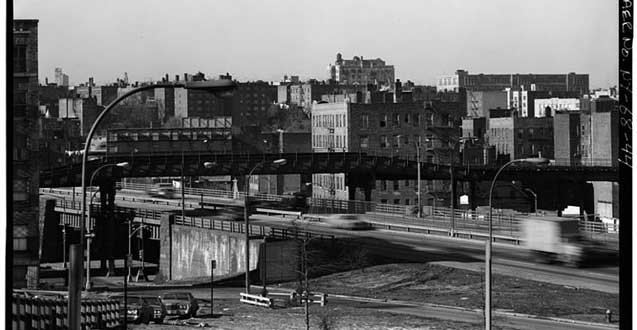 This photo of the Cross Bronx Expressway was taken by Jack E. Boucher in December 1973 or January 1974. Photo courtesy of the Library of Congress.
This photo of the Cross Bronx Expressway was taken by Jack E. Boucher in December 1973 or January 1974. Photo courtesy of the Library of Congress.
“The Bronx Is Building”
Sitting at the intersection of Kingsbridge Road and Jerome Avenue, the Kingsbridge Armory looks like a medieval castle. Get off the elevated subway platform just 40 minutes north of Downtown Manhattan and you find yourself eye-to-eye with a turret.
Yorman Nunez, who got involved in the community campaign around the Armory when he was just 13 years old, grew up a few blocks from here and would pass by on his way to school. “I always wondered,” he said, “how is there a castle there, out of nowhere?”
Opened in 1917 to house the National Guard, at least half of the sprawling building looks like something out of Camelot, with turrets and terracotta and slits in the brick battlements for archers. The other half looks more like a classical railway station, complete with vaulted steel girders, skylights, and an iron and copper roof. Standing in the gaping space, one half expects to see Anna Karenina or Sir Lancelot emerge from the shadows.
When New York Mayor Michael Bloomberg announced his support for the ice center proposal this spring, he stood with developers, politicians and skaters Hughes and Messier inside the Drill Hall and declared, “Allowing this armory to remain empty and stand as a symbol of the abandonment that once plagued the borough was simply unthinkable.”
And then he quipped, “The Bronx is building.”
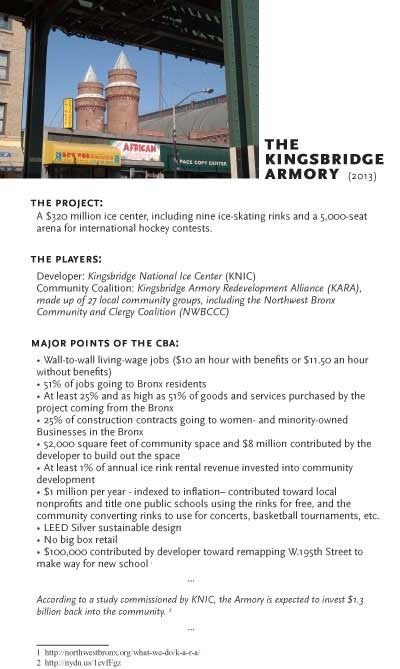 He was recalling the one phrase that’s haunted the Bronx since 1977, when sports commentator Howard Cosell uttered it during a World Series baseball game at nearby Yankee Stadium. To explain the fire and smoke caught on a live camera scanning the run-down neighborhood, Cosell said, “The Bronx is burning.”
He was recalling the one phrase that’s haunted the Bronx since 1977, when sports commentator Howard Cosell uttered it during a World Series baseball game at nearby Yankee Stadium. To explain the fire and smoke caught on a live camera scanning the run-down neighborhood, Cosell said, “The Bronx is burning.”
Years of repetition and media stereotyping have ensured that the borough’s consistently been associated in the public mind with burnt-out buildings, abandoned lots, and “urban blight”.
But the Bronx is a big, diverse place. The Northwest, where the Armory is, always stood in leafy, relatively well off contrast to where the ballpark sits, some four miles to the south. “Blight” was never the borough’s problem so much as poor policy choices by far-off decisionmakers, including redlining by government, disinvestment by banks, and “slum clearance” by master planners like Robert Moses.
Of the Armory, urban journalist and author Roberta Gratz says, “It’s a miracle that Moses didn’t put a road through it.” After redesigning much of the city (with an emphasis on parks and beaches, but also high-speed highways and slum clearance), Moses forced an expressway through the southern part of the Bronx that was completed in the 1960s.
In one mile-long stretch, the Cross Bronx Expressway demolished 1,530 apartments housing 5,000 people (by Moses’ own estimate). Of the community’s opposition—led by local mothers and grandmothers—Moses told his biographer, it was nothing but “A political thing that stirred up the animals.” To his critics, he scoffed: “I raise my stein to the builder who can remove ghettos without removing people… the chef who can make omelets without breaking eggs.”
Since Moses’ day, the Bronx has gradually re-emerged, brought back, as Gratz likes to say, “block by block” by local residents. While progress is still uneven, in the last decade the Bronx increased in population at a rate which ranks the borough near the top in growth. It’s still the county with the highest unemployment, highest infant mortality and highest obesity rate in the city, but around the Armory especially, on the east side of the Harlem River, real estate prices and rents have been rising.
The Bronx is no longer burning, but it is heating up.
Local businesses know that change is coming. On Kingsbridge Road, small family-owned stores huddle low against construction cranes that are rising all around. Across the street from the Armory, a family-owned Morton Williams is one of the few unionized grocery stores in the area. The Retail Wholesale and Department Store Union (RWDSU) hiring hall is just next-door.
A few blocks south of here lies Fordham Road, one of New York City’s busiest shopping areas, where local businesses struggle to keep competitive against huge national chains that typically hire low-wage workers and keep out unions. A few blocks north sits Target, sucking bargain-seeking customers from local shops.
Gene Bass, whose store, Forever Young Healthy Food, directly faces the Armory’s main entrance says she’ll be glad to see something other than emptiness in the building across the street. Still, she’s worried: Development nearby has rarely brought good news for union workers like those of the RWDSU or small commercial renters like Bass.
“My sister and I founded this business 22 years ago,” she said. “We want to stay.”
“Community Benefits” Means Community Buy-in
Community Benefits Agreements grew out of a frustration in cities like this one, where development, often subsidized by local taxes, has ended up profiting far-off corporations while displacing local businesses and leaving public coffers depleted.
In the late 1990s, when the first CBAs were being developed, states, counties, and cities in the United States were spending close to$50 billion in public dollars on sports stadiums, entertainment centers, big box retail malls, and upscale property development every year. Local residents could do little but protest and try to sway the city’s approval process. Benefits agreements were developed as a way to not necessarily stop development, but try to benefit from it.
Generally, CBAs take the form of private agreements between developers and community organizations that detail the benefits a developer will provide in order to secure the cooperation, or at least tolerance, of community groups regarding the developer’s application to the city for permission to develop a particular project. The first major CBA, the Los Angeles Staples agreement, was signed in 2001. Since then, scores of CBAs have been negotiated across the country, in Atlanta, Chicago, Denver, Milwaukee, Minneapolis/St. Paul, but not, until now, successfully in New York City.
“The Armory CBA is really pivotal for New York City, for the Bronx, and for CBAs,” said Julian Gross, an attorney who has worked with dozens of groups on Community Benefits Agreements—including the Staples agreement—and who consulted with the NWBCCC early on in the process.
The deal takes the form of a “cooperation agreement” between the directors of KNIC Partners and the Kingsbridge Armory Redevelopment Alliance (KARA), a team of community and labor institutions that the NWBCCC helped to found 17 years ago with the specific purpose of being a negotiating partner for developers—whenever such a developer came along.
“It‘s New York City’s first real CBA,” says Gross of the eventual deal that was reached. The deal was “driven by a legitimate community coalition, with no successful attempt by the city to control or manipulate it. It’s a real agreement with real legal language.”
There was good reason for KNIC to seek community “cooperation.” The last plan to develop the Bronx Armory went down to defeat when the developers of a proposed mall refused to come to agreement with the community over living wages. Related Companies, a major developer in New York, had secured Mayor Bloomberg’s support to buy the building for just $5 million with nearly $50 million in taxpayer subsidies and exemptions to build a mall. Related had influence, Bloomberg’s backing, and the city’s building frenzy running in its favor.
What the firm hadn’t bargained on was an organized community. NWBCCC and the RWDSU organized a year’s worth of rallies, each larger than the the one before, complete with churchleaders, celebrities, and local politicians, and the final vote in the city council was 48-1 with all the Bronx delegation voting against.
When KNIC Partners came in with the ice center deal, “We knew from the beginning that this project would only work if the community wanted it,” developer Kevin Parker told Commonomics in an email. “So we sat down with them early on to determine how we could create a worthy vision that would benefit everyone involved.”
The people of the Northwest Bronx had made themselves a credible force to be reckoned with. That’s lesson number one for groups seeking to mimic what happened in the Bronx deal, says Bettina Damiani, project director of Good Jobs New York. The community groups in the area had developed a very clear agenda for the armory years before the developers arrived.
Like most observers, Damiani singles out the Coalition: “NWBCCC didn’t just convene the players around the negotiating table; they built the table,” she said.
The roots of the Coalition reach deep. Roger Hayes (father of MSNBC’s Chris Hayes) co-founded the group in 1974, inspired by clergy who’d moved north from the southern part of the borough hit by Moses’ Expressway. Parish-priests are place-based organizers by definition; those eggs in the developers’ omelet are their parishioners.
The Bronx clergy had seen what happened when people moved en masse, leaving buildings empty and blocks vacant. With members who were Irish, Latino, Jewish, Italian, African-American, and Caribbean, the Coalition also drew on the Bronx’s hefty population of organized, socialist, and immigrant families who’d moved north from Manhattan’s Lower East Side tenements. “People came from very different places,” said Hayes, “but the church leadership was very sophisticated; they’d sit down with anyone and talk.”
In the years when landlords stayed away and banks and government divested, “NWBCCC was there,” says Hayes. (By the mid-2000s, the group had 4,000-5,000 active members with experience providing services, occupying and managing buildings, protesting banker bias, and electing representatives to office.)
So in the mid-1990s, when the NWBCCC held mass meetings to imagine a new future for the Kingsbridge Armory, hundreds of people attended. When they invited local politicians to sign on to their list of priorities for the building (which became the basis for the CBA), those politicians signed on.
In the run up to the vote on the Related company’s mall, NWBCCC members marched from a local church to the armory and wrapped the entire building in yellow caution tape. Ava Farkas, who was the NWBCCC armory organizer at the time, recalls: “The tape read, ‘It’s our Armory’, and that’s really how it felt. The community felt ownership over it. It was our space.”
After the City Council rejected the mall, Mayor Bloomberg blamed small groups of people “out to feather their own nests and extort money from the developer.”
But hurled at NWBCCC, that charge didn’t stick.
“We’d been dealing for years with a view of the Bronx from people who didn’t live there,” said Mary Dailey, who worked with the NWBCCC for a decade before becoming its director in 2004-2005. “People in the community looked at it from the perspective, what would make this a better place to live?”
At the time of the shopping mall proposal, average Bronx retail workers were earning about $16,700 a year. Low wages forced workers to rely on taxpayer subsidized safety net programs just to make ends meet. Millions of dollars in public subsidies for more poverty-level wages and more people needing food stamps were not on the community’s list of priorities.
Lesson number two: Organize for forty years?
It’s here that the Bronx story gets hard to mimic. Not every community is blessed with a 40-year-old coalition, immune to the criticism that the signatories to the agreements are self-selecting and unrepresentative.
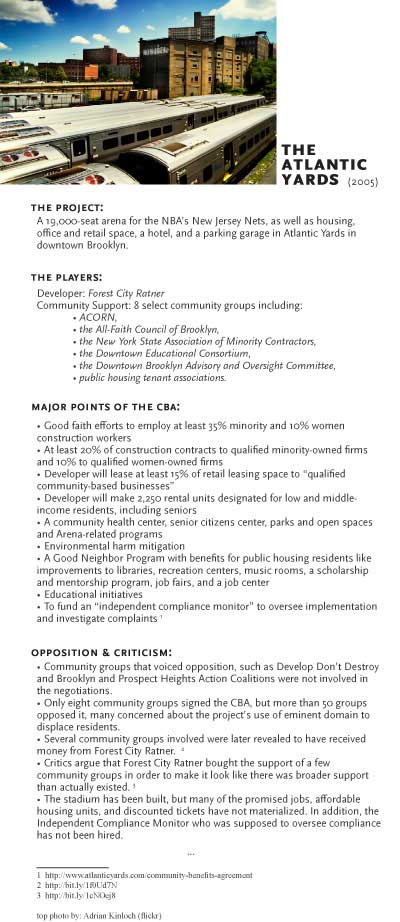 In Brooklyn, signatories to a CBA negotiated with the developers of the Atlantic Yards redevelopment hailed that agreement as a great achievement, too. Opponents saw those signatories as pawns, and the CBA as a tool the developers had used to manufacture the appearance of consent and co-opt local politicians.
In Brooklyn, signatories to a CBA negotiated with the developers of the Atlantic Yards redevelopment hailed that agreement as a great achievement, too. Opponents saw those signatories as pawns, and the CBA as a tool the developers had used to manufacture the appearance of consent and co-opt local politicians.
In the Bronx, another Related Companies plan to redevelop the Bronx Terminal Market into a retail complex was approved after a CBA, negotiated by local politicians, was finalized just before the City Council voted. Almost immediately questions were raised about kickbacks to the politicians involved. And 17 months after a similar deal was reached around construction of a new Yankee Stadium, the New York Times reported that community groups had still not received any of the promised funds from the New York Yankees (see sidebar further down).
Even though the NWBCCC is massively popular in the Bronx, some residents still wonder how KNIC got chosen over an alternative proposal.
Legendary DJ Afrika Bambaataa and an alliance of Hip Hop stars backed a different developer, Youngwoo and Associates, whose plan for the armory included a “Mercado Mirabo”—a community “plaza”-style market—and “town square” with a mix of food, entertainment, cultural space, and $10/month gym access for Bronx residents.
The Youngwoo proposal also included a Hip Hop Museum. “An international museum of Hip Hop, located in the Bronx where the movement started, will attract worldwide recognition and bring visitors from around the globe” said Bambaataa at the time.
Pilgrim-Hunter says the Youngwoo company wouldn’t commit to all of the points of KARA’s proposed CBA. Sources close to Youngwoo say the CBA process encourages developers to promise more than they can actually deliver. Youngwoo still believes its plan more closely reflected the community’s expressed priorities than world-class ice skating.
At the end of the day, the benefits promised under the CBA hang on the success of the KNIC business model.
“We wish the best for the community. The armory project is a very visible place and this is a very big project,” said Adam Zucker, Director of Business Development at Youngwoo. “The community made itself a strong player and they deserve something great.”
Less charitably, others wonder if KNIC’s goal of attracting 2 million visitors annually to the Bronx is realistic. After an initial contribution of $8 million for construction of community space and support for local business developments, the benefits KNIC will contribute to the community hang on the success of the overall project. Most of the benefits are in-kind, and while there will be many different ice sports on offer, none is particularly associated with the urban people of color and immigrants who dominate the Northwest Bronx community. Perhaps the KNIC will change the hue of the NHL.
Still, a lot is riding on the ice.
The Best Tool in Town?
You can almost feel the neighborhood’s residents actively willing the ice center development to be successful. Asked if he was a skater, the security guard minding the armory’s massive loading door this November beamed broadly and exclaimed, “No. But I’m going to be.”
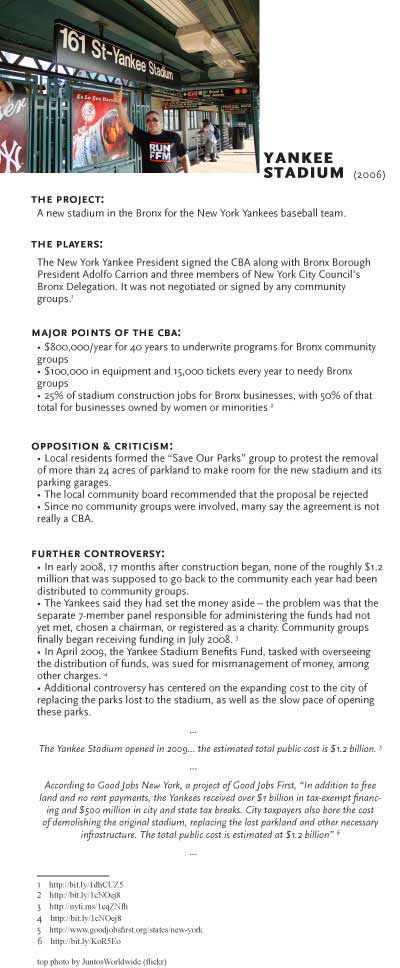 Gabriel Vangelatos, son of the owner of the New Capital Diner across the street, is considering adding special dishes to his menu for visiting Canadians. Referring to the former New York Rangers Hockey star who’s agreed to serve as CEO of the Center, Vangelatos says, “Mark Messier was my childhood hero. What’ s not to like?”
Gabriel Vangelatos, son of the owner of the New Capital Diner across the street, is considering adding special dishes to his menu for visiting Canadians. Referring to the former New York Rangers Hockey star who’s agreed to serve as CEO of the Center, Vangelatos says, “Mark Messier was my childhood hero. What’ s not to like?”
Nonetheless, in calling the armory deal the city’s first “real” CBA, supporters sidestep the poor record of area CBAs until now.
“New York’s past CBAs weren’t enforceable. This one is,” says attorney Gross.
Sure enough, KNIC and KARA are signatories to a legal pact. Still, Tom Angotti, who teaches urban affairs at Hunter College, says if the Center fails to deliver, “KARA can sue but they’ve got to find a lawyer and take them to court. Good luck with that.”
Angotti served on a citywide task force on CBAs in 2010 that concluded that the process needed to conform to clear, uniform standards. Even then, he adds, “CBAs are a community’s next best alternative to getting what they actually wanted.”
Roberta Gratz, author of The Battle for Gotham, is even more skeptical: “Real estate power still owns the city,” she says. “When a community’s strategy to get what it really wants has failed, CBAs are a way to get the best out of a bad situation.” (The Coalition’s original proposal for the armory, drawn up after lots of community meetings, included three 800-seat schools to address school overcrowding, a sports complex, a green market, a bookstore, a community center, and a park. Not skating.)
Ideally, cities would have strong policies on the books, covering affordable housing, local hiring, and living-wages (that are really livable)—in which case, communities wouldn’t have to work though these deals on a case-by-case basis.
“If community groups had confidence that cities would negotiate and enforce those things, they wouldn’t need CBAs” says Gross.
Similarly, if the public process through which development proposals were approved was reliable, accountable, and adequately funded, public bodies (like community boards, in New York City) could do their own research on the kind of development that would truly benefit neighborhoods, and community organizations like the NWBCCC wouldn’t have to hire their own consultants and run the risk of being called “unrepresentative.”
“As a practical matter, the best place for the planning to go on is at community board level,” says professor Angotti.
New York City residents ostensibly have a say in the planning process through community boards that vote on land use and development proposals. But board members are appointed volunteers with little to no staff. They struggle—especially in working-class neighborhoods—to deal with day-to-day business, let alone planning for the long-term, and with public resources always stretched board budgets are on the chopping block.
“They’re the community planning institution and they’re a failed institution,” says Agnotti.
In a developer-driven process, CBAs may be the best tool in town. But they’re not the end of the story for communities seeking a say in their own future.
Next Steps to Community Wealth
“One of the things we’re looking forward to [in the Bronx],” says Pilgrim-Hunter, “is people in our community becoming the developers. That will be the testament to what started here: [If], 20 years from now, we have given birth to other folks from the Bronx owning their own businesses.”
Pilgrim-Hunter’s not alone in seeing the Kingsbridge Armory CBA as just the first step in a longer journey for the borough. To get where she wants the Bronx to go, she says, “It’s going to take community partnerships with development and businesses; it’s going to take leaders actively advocating; and its going to take legislation, and all of us being able to understand and pass laws to support community ownership…”
After the defeat of the Related shopping center, Ava Farkas, the former Coalition organizer, moved on to work for living-wage policies—not for developments in the Bronx, but for any development receiving public subsidies anywhere in New York City.
“It was the logical next step, to take the energy we’d unleashed and pass legislation so that neighborhoods don’t have to fight with every developer,” says Farkas.
In June of 2012, the Fair Wages for New Yorkers Act passed. Under the terms of the legislation, any private developer accepting $1 million or more in subsidies must now pay employees a living wage of $10/hour with benefits, or $11.50 without. The Act was co-sponsored by Oliver Koppel, a Bronx Democrat, whose council district borders the armory.
“People didn’t think we could go up against Related and win, and we did,” says Farkas. “They didn’t think we could pass living wages either. But we did… Organizing works.”
Yorman Nunez, who was 13 when he first got involved in the Coalition, believes that that local procurement goals in the Bronx Armory CBA can be a catalyst for building more wealth in the borough. Around the Armory fight, he says, “We learned that although our organizing has been getting better and better, our membership base has been getting poorer and poorer. That’s because wealth is leaking out of the borough.”
Residents had energy and ideas for the armory long before the city or any developer had a plan, but no resources to implement them: “We’re the ones that got people together to come up with ideas [for the armory]” he said. “We got the city to fix the roof, but only outsiders had the wealth to develop it.”
Today, Nunez is co-coordinator of the Bronx Cooperative Development Initiative. To evaluate the borough’s internal resources, the Initiative commissioned a study, led by Jeffrey Hollender of Seventh Generation and the American Sustainable Business Council, that took a close look at the borough’s challenges and assets. Nunez intends to use the research to provide KNIC with a database of local vendors.
The Initiative includes local business leaders, organized labor, and anchor institutions, including Montefiore Medical Center, Fordham University, Hostos Community College, Bronx Community College, the New York Botanical Garden, and the Bronx Zoo, as well as local nonprofits like the Northwest Bronx Community and Clergy Coalition, Mothers on the Move, the Northern Manhattan Coalition for Immigrant Rights, and others.
Pilgrim-Hunter considered a run for state senate in 2010. She says she’s ruled out another run. For now, she says she’s looking forward to the armory setting a new standard for development in communities across the country: Development in which “community, businesses, government, and politicians come together to plan community redevelopment—not in opposition but together.”
Reached on the day after the city council vote, she said that she intends to take some time off—to celebrate the armory win with her grandchildren.
“It’s my younger Daughter Cassandra and [her son] Cole’s faces that keep me going,” she explained. Pilgrim-Hunter recently heard that her daughter’s family were moving to North Carolina.
Cassandra has two jobs—one in mid-town Manhattan and the other upstate. “[Cassandra] has spent her whole life commuting to school and now trying to piece together work,” Pilgrim-Hunter told me.
“I’m heartbroken to be losing my daughter to another state. By the time my grandson Cole is old enough my hope is establishing these kind of living-wage development projects will mean my daughter won’t have to hear the same thing from him. He can stay close to home because he’ll be able to find work he can thrive on.”
24 Hours Left: All gifts to Truthout now matched!
From now until the end of the year, all donations to Truthout will be matched dollar for dollar up to $22,000! Thanks to a generous supporter, your one-time gift today will be matched immediately. As well, your monthly donation will be matched for the whole first year, doubling your impact.
We have just 24 hours left to raise $22,000 and receive the full match.
This matching gift comes at a critical time. As Trump attempts to silence dissenting voices and oppositional nonprofits, reader support is our best defense against the right-wing agenda.
Help Truthout confront Trump’s fascism in 2026, and have your donation matched now!